MGBBT0UBN - Business Organisations: Structure, Functions & Culture
VerifiedAdded on 2023/06/10
|8
|2131
|430
Essay
AI Summary
This essay provides a comprehensive overview of business organizations, covering various aspects such as different types of business structures (sole trader, partnership, limited company) and their advantages and disadvantages. It compares tall and flat organizational structures using examples from the hospitality industry, like Hilton and Starbucks, and discusses the impact of different business functions, including Human Resources Management, Production Management, and Operation Management, on management activities. Furthermore, the essay explains how organizational structure and a positive organizational culture can contribute to the success of a firm, emphasizing the importance of employee performance, engagement, and productivity. The report concludes by highlighting the significance of a well-defined organizational structure and positive culture in achieving business goals and enhancing profitability.
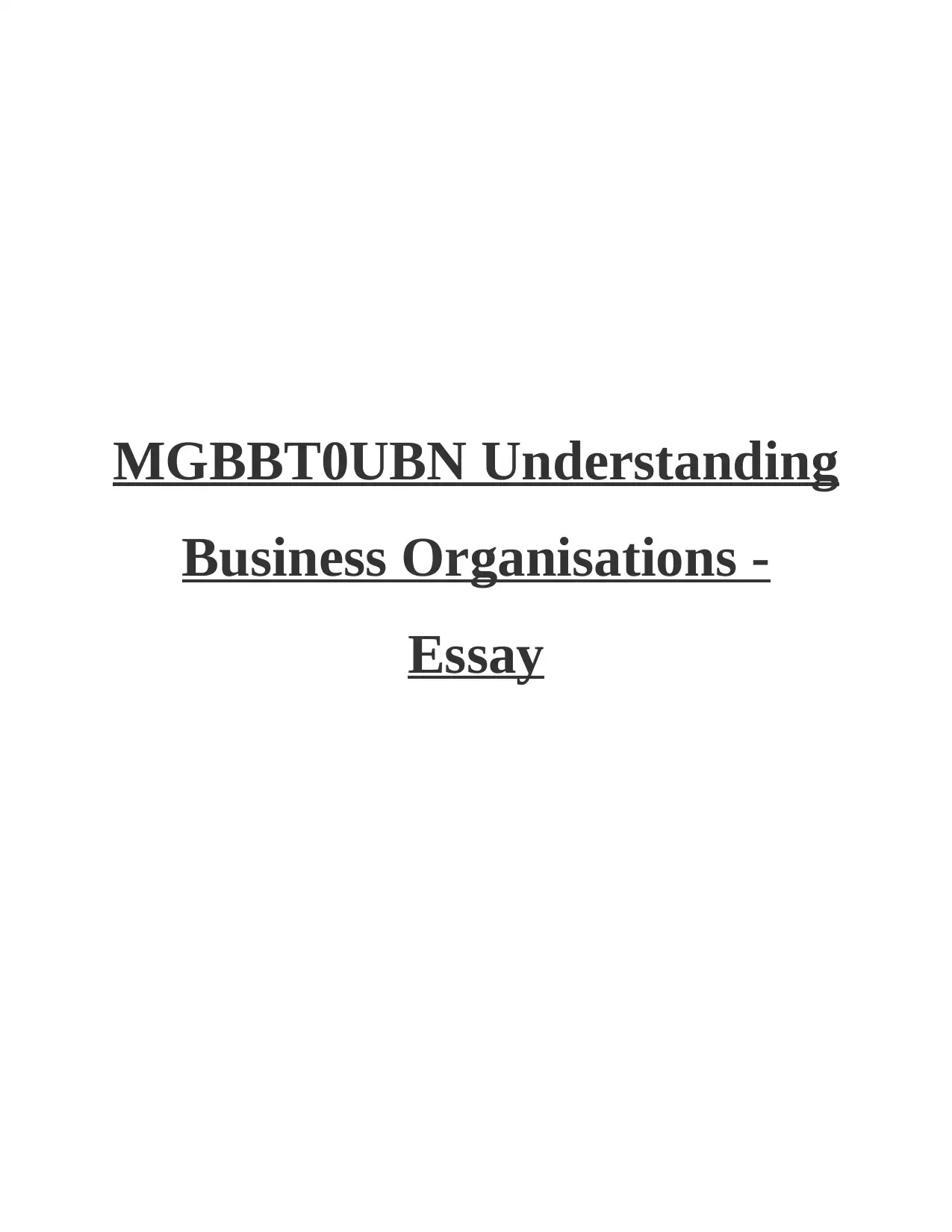
MGBBT0UBN Understanding
Business Organisations -
Essay
Business Organisations -
Essay
Paraphrase This Document
Need a fresh take? Get an instant paraphrase of this document with our AI Paraphraser
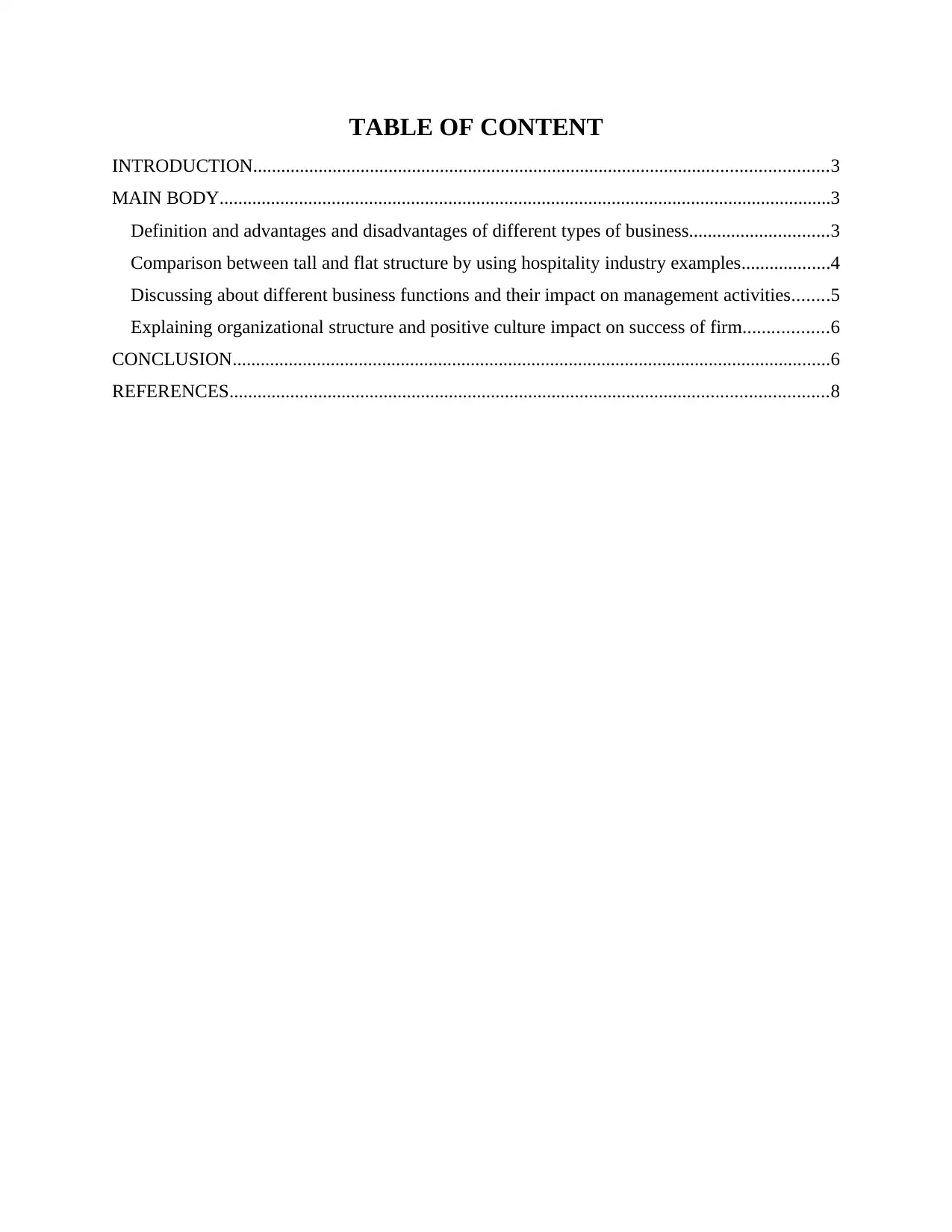
TABLE OF CONTENT
INTRODUCTION...........................................................................................................................3
MAIN BODY...................................................................................................................................3
Definition and advantages and disadvantages of different types of business..............................3
Comparison between tall and flat structure by using hospitality industry examples...................4
Discussing about different business functions and their impact on management activities........5
Explaining organizational structure and positive culture impact on success of firm..................6
CONCLUSION................................................................................................................................6
REFERENCES................................................................................................................................8
INTRODUCTION...........................................................................................................................3
MAIN BODY...................................................................................................................................3
Definition and advantages and disadvantages of different types of business..............................3
Comparison between tall and flat structure by using hospitality industry examples...................4
Discussing about different business functions and their impact on management activities........5
Explaining organizational structure and positive culture impact on success of firm..................6
CONCLUSION................................................................................................................................6
REFERENCES................................................................................................................................8
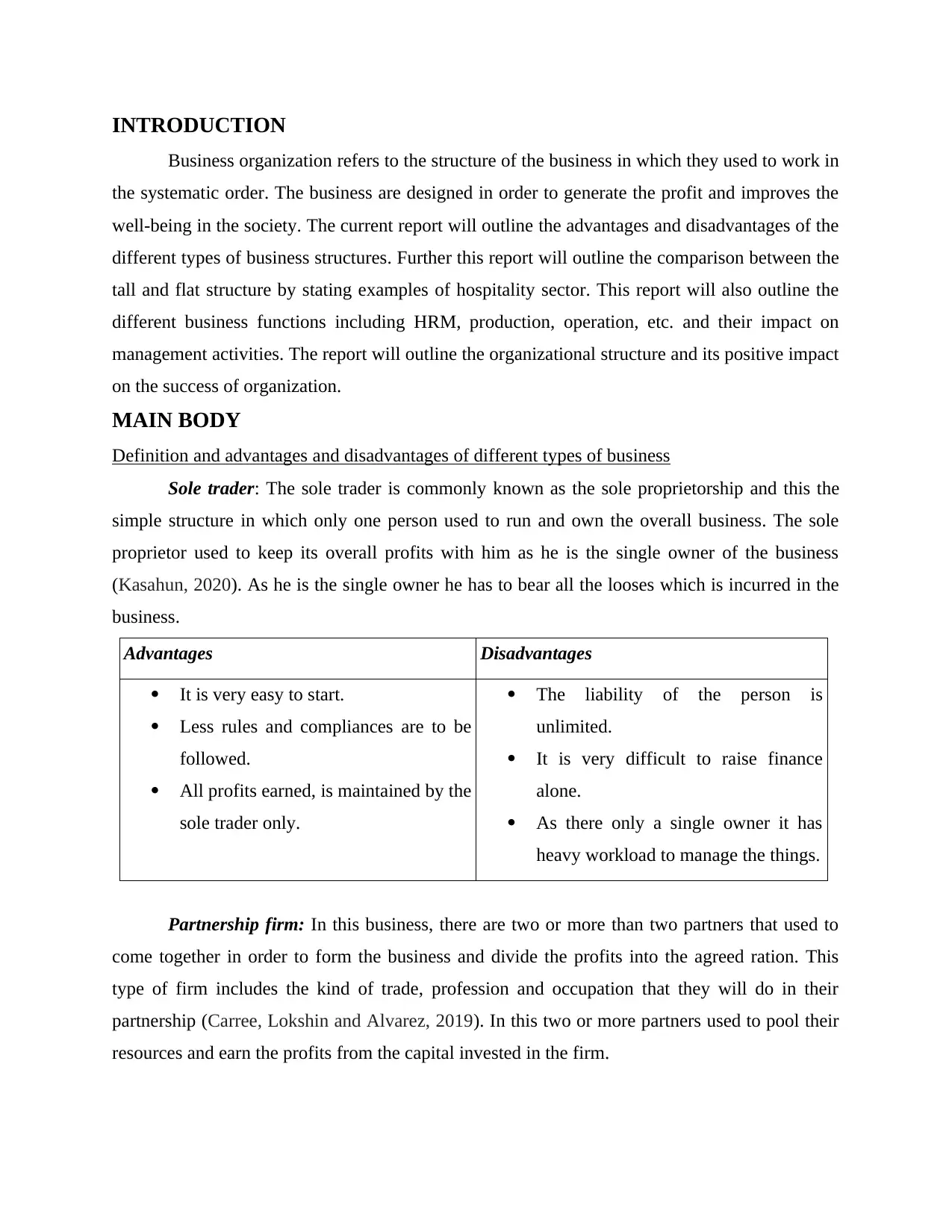
INTRODUCTION
Business organization refers to the structure of the business in which they used to work in
the systematic order. The business are designed in order to generate the profit and improves the
well-being in the society. The current report will outline the advantages and disadvantages of the
different types of business structures. Further this report will outline the comparison between the
tall and flat structure by stating examples of hospitality sector. This report will also outline the
different business functions including HRM, production, operation, etc. and their impact on
management activities. The report will outline the organizational structure and its positive impact
on the success of organization.
MAIN BODY
Definition and advantages and disadvantages of different types of business
Sole trader: The sole trader is commonly known as the sole proprietorship and this the
simple structure in which only one person used to run and own the overall business. The sole
proprietor used to keep its overall profits with him as he is the single owner of the business
(Kasahun, 2020). As he is the single owner he has to bear all the looses which is incurred in the
business.
Advantages Disadvantages
It is very easy to start.
Less rules and compliances are to be
followed.
All profits earned, is maintained by the
sole trader only.
The liability of the person is
unlimited.
It is very difficult to raise finance
alone.
As there only a single owner it has
heavy workload to manage the things.
Partnership firm: In this business, there are two or more than two partners that used to
come together in order to form the business and divide the profits into the agreed ration. This
type of firm includes the kind of trade, profession and occupation that they will do in their
partnership (Carree, Lokshin and Alvarez, 2019). In this two or more partners used to pool their
resources and earn the profits from the capital invested in the firm.
Business organization refers to the structure of the business in which they used to work in
the systematic order. The business are designed in order to generate the profit and improves the
well-being in the society. The current report will outline the advantages and disadvantages of the
different types of business structures. Further this report will outline the comparison between the
tall and flat structure by stating examples of hospitality sector. This report will also outline the
different business functions including HRM, production, operation, etc. and their impact on
management activities. The report will outline the organizational structure and its positive impact
on the success of organization.
MAIN BODY
Definition and advantages and disadvantages of different types of business
Sole trader: The sole trader is commonly known as the sole proprietorship and this the
simple structure in which only one person used to run and own the overall business. The sole
proprietor used to keep its overall profits with him as he is the single owner of the business
(Kasahun, 2020). As he is the single owner he has to bear all the looses which is incurred in the
business.
Advantages Disadvantages
It is very easy to start.
Less rules and compliances are to be
followed.
All profits earned, is maintained by the
sole trader only.
The liability of the person is
unlimited.
It is very difficult to raise finance
alone.
As there only a single owner it has
heavy workload to manage the things.
Partnership firm: In this business, there are two or more than two partners that used to
come together in order to form the business and divide the profits into the agreed ration. This
type of firm includes the kind of trade, profession and occupation that they will do in their
partnership (Carree, Lokshin and Alvarez, 2019). In this two or more partners used to pool their
resources and earn the profits from the capital invested in the firm.
⊘ This is a preview!⊘
Do you want full access?
Subscribe today to unlock all pages.

Trusted by 1+ million students worldwide
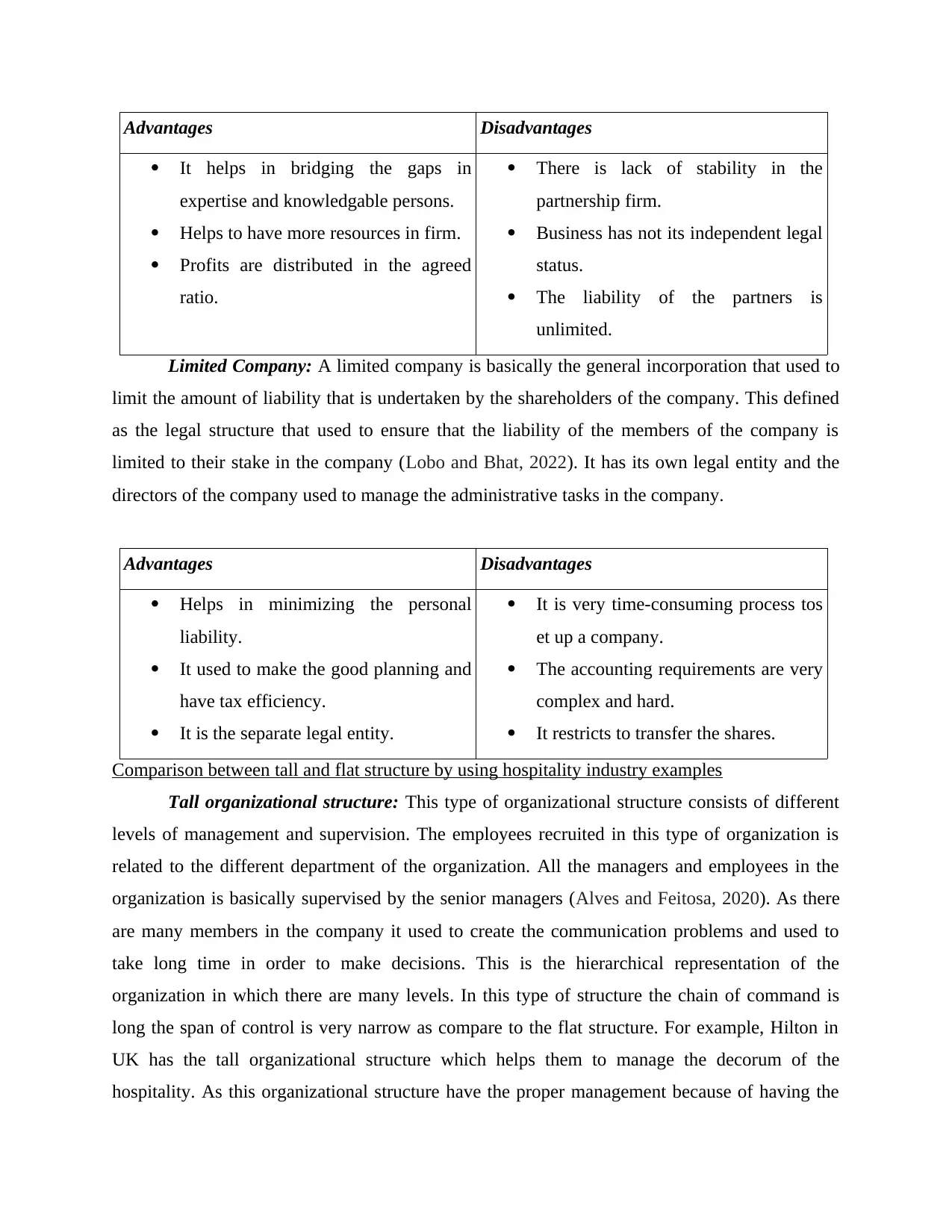
Advantages Disadvantages
It helps in bridging the gaps in
expertise and knowledgable persons.
Helps to have more resources in firm.
Profits are distributed in the agreed
ratio.
There is lack of stability in the
partnership firm.
Business has not its independent legal
status.
The liability of the partners is
unlimited.
Limited Company: A limited company is basically the general incorporation that used to
limit the amount of liability that is undertaken by the shareholders of the company. This defined
as the legal structure that used to ensure that the liability of the members of the company is
limited to their stake in the company (Lobo and Bhat, 2022). It has its own legal entity and the
directors of the company used to manage the administrative tasks in the company.
Advantages Disadvantages
Helps in minimizing the personal
liability.
It used to make the good planning and
have tax efficiency.
It is the separate legal entity.
It is very time-consuming process tos
et up a company.
The accounting requirements are very
complex and hard.
It restricts to transfer the shares.
Comparison between tall and flat structure by using hospitality industry examples
Tall organizational structure: This type of organizational structure consists of different
levels of management and supervision. The employees recruited in this type of organization is
related to the different department of the organization. All the managers and employees in the
organization is basically supervised by the senior managers (Alves and Feitosa, 2020). As there
are many members in the company it used to create the communication problems and used to
take long time in order to make decisions. This is the hierarchical representation of the
organization in which there are many levels. In this type of structure the chain of command is
long the span of control is very narrow as compare to the flat structure. For example, Hilton in
UK has the tall organizational structure which helps them to manage the decorum of the
hospitality. As this organizational structure have the proper management because of having the
It helps in bridging the gaps in
expertise and knowledgable persons.
Helps to have more resources in firm.
Profits are distributed in the agreed
ratio.
There is lack of stability in the
partnership firm.
Business has not its independent legal
status.
The liability of the partners is
unlimited.
Limited Company: A limited company is basically the general incorporation that used to
limit the amount of liability that is undertaken by the shareholders of the company. This defined
as the legal structure that used to ensure that the liability of the members of the company is
limited to their stake in the company (Lobo and Bhat, 2022). It has its own legal entity and the
directors of the company used to manage the administrative tasks in the company.
Advantages Disadvantages
Helps in minimizing the personal
liability.
It used to make the good planning and
have tax efficiency.
It is the separate legal entity.
It is very time-consuming process tos
et up a company.
The accounting requirements are very
complex and hard.
It restricts to transfer the shares.
Comparison between tall and flat structure by using hospitality industry examples
Tall organizational structure: This type of organizational structure consists of different
levels of management and supervision. The employees recruited in this type of organization is
related to the different department of the organization. All the managers and employees in the
organization is basically supervised by the senior managers (Alves and Feitosa, 2020). As there
are many members in the company it used to create the communication problems and used to
take long time in order to make decisions. This is the hierarchical representation of the
organization in which there are many levels. In this type of structure the chain of command is
long the span of control is very narrow as compare to the flat structure. For example, Hilton in
UK has the tall organizational structure which helps them to manage the decorum of the
hospitality. As this organizational structure have the proper management because of having the
Paraphrase This Document
Need a fresh take? Get an instant paraphrase of this document with our AI Paraphraser
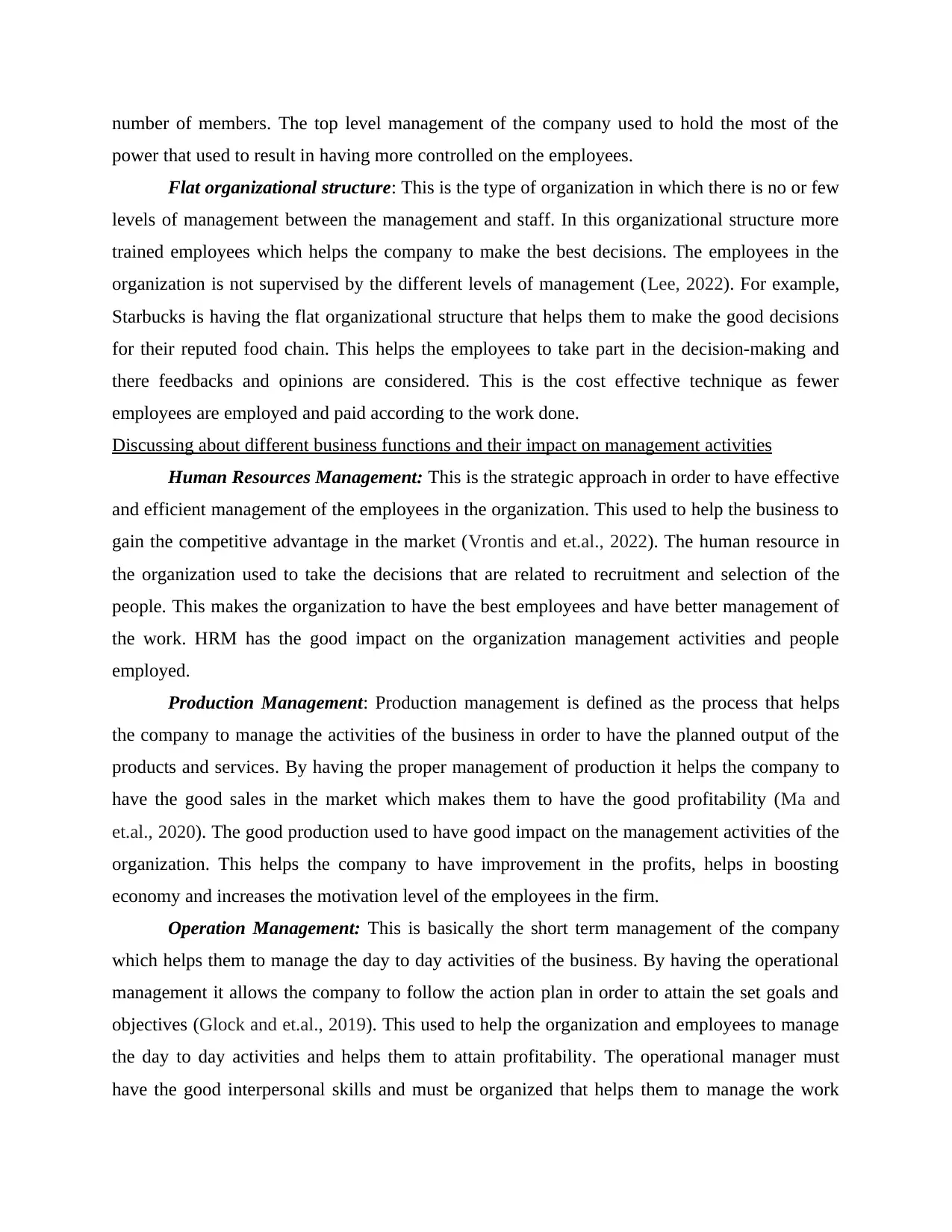
number of members. The top level management of the company used to hold the most of the
power that used to result in having more controlled on the employees.
Flat organizational structure: This is the type of organization in which there is no or few
levels of management between the management and staff. In this organizational structure more
trained employees which helps the company to make the best decisions. The employees in the
organization is not supervised by the different levels of management (Lee, 2022). For example,
Starbucks is having the flat organizational structure that helps them to make the good decisions
for their reputed food chain. This helps the employees to take part in the decision-making and
there feedbacks and opinions are considered. This is the cost effective technique as fewer
employees are employed and paid according to the work done.
Discussing about different business functions and their impact on management activities
Human Resources Management: This is the strategic approach in order to have effective
and efficient management of the employees in the organization. This used to help the business to
gain the competitive advantage in the market (Vrontis and et.al., 2022). The human resource in
the organization used to take the decisions that are related to recruitment and selection of the
people. This makes the organization to have the best employees and have better management of
the work. HRM has the good impact on the organization management activities and people
employed.
Production Management: Production management is defined as the process that helps
the company to manage the activities of the business in order to have the planned output of the
products and services. By having the proper management of production it helps the company to
have the good sales in the market which makes them to have the good profitability (Ma and
et.al., 2020). The good production used to have good impact on the management activities of the
organization. This helps the company to have improvement in the profits, helps in boosting
economy and increases the motivation level of the employees in the firm.
Operation Management: This is basically the short term management of the company
which helps them to manage the day to day activities of the business. By having the operational
management it allows the company to follow the action plan in order to attain the set goals and
objectives (Glock and et.al., 2019). This used to help the organization and employees to manage
the day to day activities and helps them to attain profitability. The operational manager must
have the good interpersonal skills and must be organized that helps them to manage the work
power that used to result in having more controlled on the employees.
Flat organizational structure: This is the type of organization in which there is no or few
levels of management between the management and staff. In this organizational structure more
trained employees which helps the company to make the best decisions. The employees in the
organization is not supervised by the different levels of management (Lee, 2022). For example,
Starbucks is having the flat organizational structure that helps them to make the good decisions
for their reputed food chain. This helps the employees to take part in the decision-making and
there feedbacks and opinions are considered. This is the cost effective technique as fewer
employees are employed and paid according to the work done.
Discussing about different business functions and their impact on management activities
Human Resources Management: This is the strategic approach in order to have effective
and efficient management of the employees in the organization. This used to help the business to
gain the competitive advantage in the market (Vrontis and et.al., 2022). The human resource in
the organization used to take the decisions that are related to recruitment and selection of the
people. This makes the organization to have the best employees and have better management of
the work. HRM has the good impact on the organization management activities and people
employed.
Production Management: Production management is defined as the process that helps
the company to manage the activities of the business in order to have the planned output of the
products and services. By having the proper management of production it helps the company to
have the good sales in the market which makes them to have the good profitability (Ma and
et.al., 2020). The good production used to have good impact on the management activities of the
organization. This helps the company to have improvement in the profits, helps in boosting
economy and increases the motivation level of the employees in the firm.
Operation Management: This is basically the short term management of the company
which helps them to manage the day to day activities of the business. By having the operational
management it allows the company to follow the action plan in order to attain the set goals and
objectives (Glock and et.al., 2019). This used to help the organization and employees to manage
the day to day activities and helps them to attain profitability. The operational manager must
have the good interpersonal skills and must be organized that helps them to manage the work
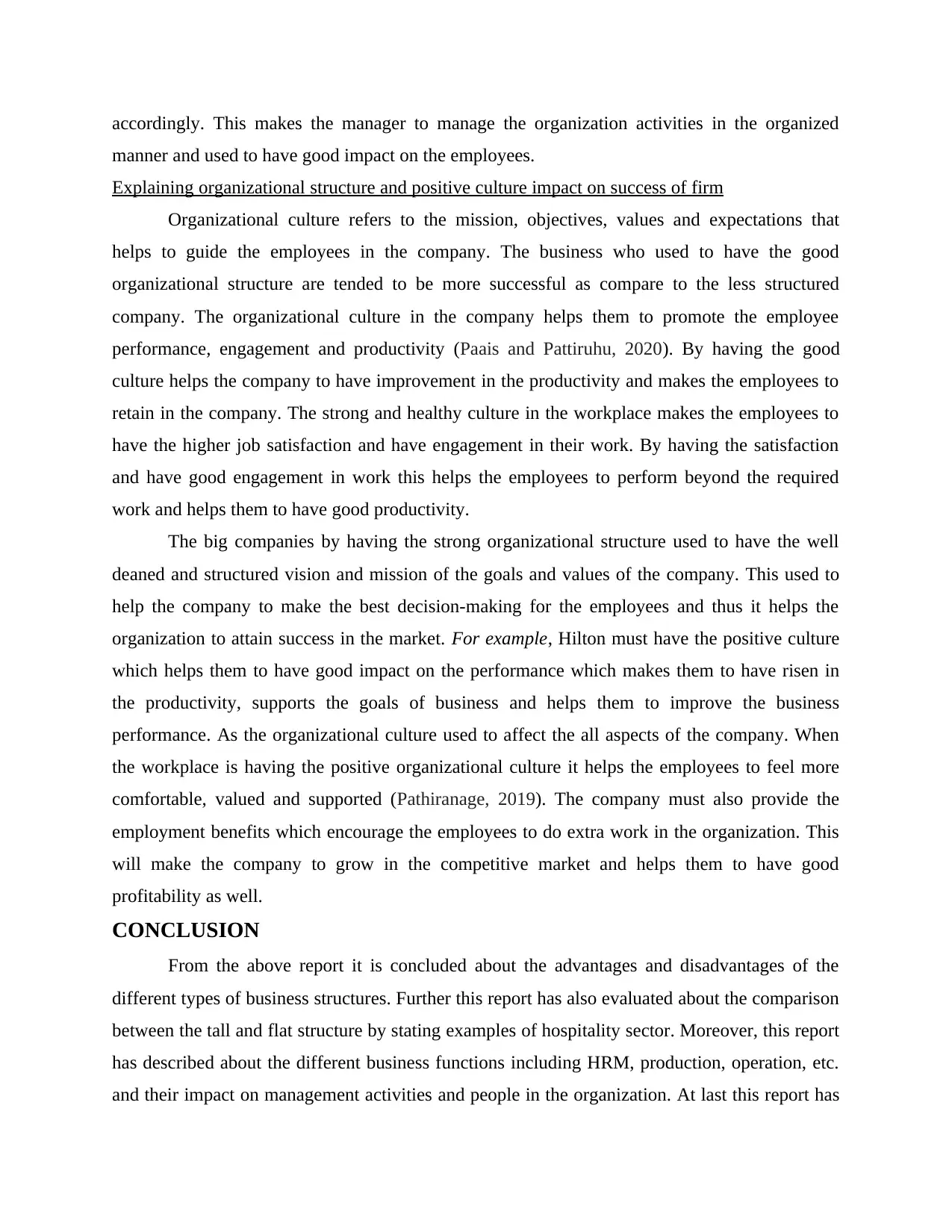
accordingly. This makes the manager to manage the organization activities in the organized
manner and used to have good impact on the employees.
Explaining organizational structure and positive culture impact on success of firm
Organizational culture refers to the mission, objectives, values and expectations that
helps to guide the employees in the company. The business who used to have the good
organizational structure are tended to be more successful as compare to the less structured
company. The organizational culture in the company helps them to promote the employee
performance, engagement and productivity (Paais and Pattiruhu, 2020). By having the good
culture helps the company to have improvement in the productivity and makes the employees to
retain in the company. The strong and healthy culture in the workplace makes the employees to
have the higher job satisfaction and have engagement in their work. By having the satisfaction
and have good engagement in work this helps the employees to perform beyond the required
work and helps them to have good productivity.
The big companies by having the strong organizational structure used to have the well
deaned and structured vision and mission of the goals and values of the company. This used to
help the company to make the best decision-making for the employees and thus it helps the
organization to attain success in the market. For example, Hilton must have the positive culture
which helps them to have good impact on the performance which makes them to have risen in
the productivity, supports the goals of business and helps them to improve the business
performance. As the organizational culture used to affect the all aspects of the company. When
the workplace is having the positive organizational culture it helps the employees to feel more
comfortable, valued and supported (Pathiranage, 2019). The company must also provide the
employment benefits which encourage the employees to do extra work in the organization. This
will make the company to grow in the competitive market and helps them to have good
profitability as well.
CONCLUSION
From the above report it is concluded about the advantages and disadvantages of the
different types of business structures. Further this report has also evaluated about the comparison
between the tall and flat structure by stating examples of hospitality sector. Moreover, this report
has described about the different business functions including HRM, production, operation, etc.
and their impact on management activities and people in the organization. At last this report has
manner and used to have good impact on the employees.
Explaining organizational structure and positive culture impact on success of firm
Organizational culture refers to the mission, objectives, values and expectations that
helps to guide the employees in the company. The business who used to have the good
organizational structure are tended to be more successful as compare to the less structured
company. The organizational culture in the company helps them to promote the employee
performance, engagement and productivity (Paais and Pattiruhu, 2020). By having the good
culture helps the company to have improvement in the productivity and makes the employees to
retain in the company. The strong and healthy culture in the workplace makes the employees to
have the higher job satisfaction and have engagement in their work. By having the satisfaction
and have good engagement in work this helps the employees to perform beyond the required
work and helps them to have good productivity.
The big companies by having the strong organizational structure used to have the well
deaned and structured vision and mission of the goals and values of the company. This used to
help the company to make the best decision-making for the employees and thus it helps the
organization to attain success in the market. For example, Hilton must have the positive culture
which helps them to have good impact on the performance which makes them to have risen in
the productivity, supports the goals of business and helps them to improve the business
performance. As the organizational culture used to affect the all aspects of the company. When
the workplace is having the positive organizational culture it helps the employees to feel more
comfortable, valued and supported (Pathiranage, 2019). The company must also provide the
employment benefits which encourage the employees to do extra work in the organization. This
will make the company to grow in the competitive market and helps them to have good
profitability as well.
CONCLUSION
From the above report it is concluded about the advantages and disadvantages of the
different types of business structures. Further this report has also evaluated about the comparison
between the tall and flat structure by stating examples of hospitality sector. Moreover, this report
has described about the different business functions including HRM, production, operation, etc.
and their impact on management activities and people in the organization. At last this report has
⊘ This is a preview!⊘
Do you want full access?
Subscribe today to unlock all pages.

Trusted by 1+ million students worldwide
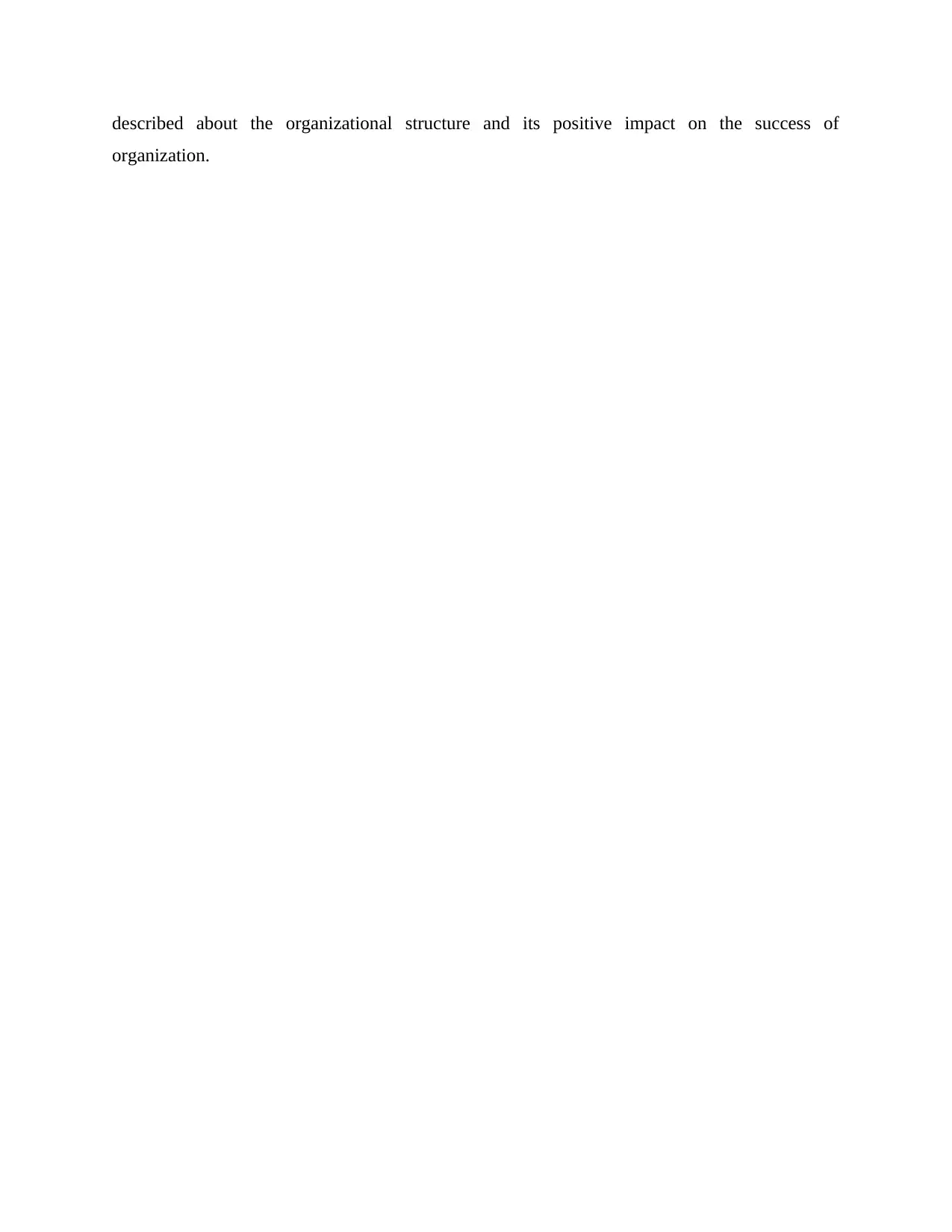
described about the organizational structure and its positive impact on the success of
organization.
organization.
Paraphrase This Document
Need a fresh take? Get an instant paraphrase of this document with our AI Paraphraser
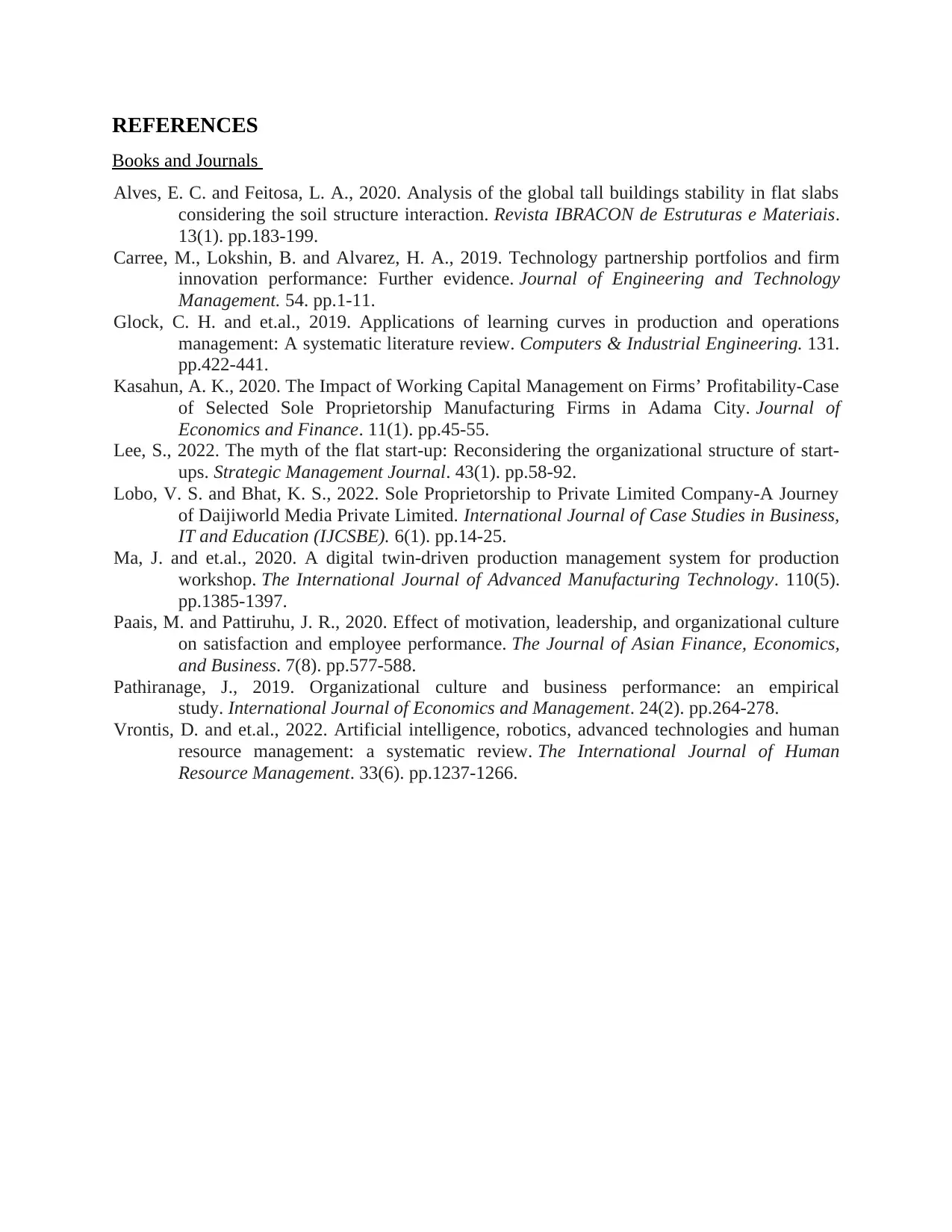
REFERENCES
Books and Journals
Alves, E. C. and Feitosa, L. A., 2020. Analysis of the global tall buildings stability in flat slabs
considering the soil structure interaction. Revista IBRACON de Estruturas e Materiais.
13(1). pp.183-199.
Carree, M., Lokshin, B. and Alvarez, H. A., 2019. Technology partnership portfolios and firm
innovation performance: Further evidence. Journal of Engineering and Technology
Management. 54. pp.1-11.
Glock, C. H. and et.al., 2019. Applications of learning curves in production and operations
management: A systematic literature review. Computers & Industrial Engineering. 131.
pp.422-441.
Kasahun, A. K., 2020. The Impact of Working Capital Management on Firms’ Profitability-Case
of Selected Sole Proprietorship Manufacturing Firms in Adama City. Journal of
Economics and Finance. 11(1). pp.45-55.
Lee, S., 2022. The myth of the flat start‐up: Reconsidering the organizational structure of start‐
ups. Strategic Management Journal. 43(1). pp.58-92.
Lobo, V. S. and Bhat, K. S., 2022. Sole Proprietorship to Private Limited Company-A Journey
of Daijiworld Media Private Limited. International Journal of Case Studies in Business,
IT and Education (IJCSBE). 6(1). pp.14-25.
Ma, J. and et.al., 2020. A digital twin-driven production management system for production
workshop. The International Journal of Advanced Manufacturing Technology. 110(5).
pp.1385-1397.
Paais, M. and Pattiruhu, J. R., 2020. Effect of motivation, leadership, and organizational culture
on satisfaction and employee performance. The Journal of Asian Finance, Economics,
and Business. 7(8). pp.577-588.
Pathiranage, J., 2019. Organizational culture and business performance: an empirical
study. International Journal of Economics and Management. 24(2). pp.264-278.
Vrontis, D. and et.al., 2022. Artificial intelligence, robotics, advanced technologies and human
resource management: a systematic review. The International Journal of Human
Resource Management. 33(6). pp.1237-1266.
Books and Journals
Alves, E. C. and Feitosa, L. A., 2020. Analysis of the global tall buildings stability in flat slabs
considering the soil structure interaction. Revista IBRACON de Estruturas e Materiais.
13(1). pp.183-199.
Carree, M., Lokshin, B. and Alvarez, H. A., 2019. Technology partnership portfolios and firm
innovation performance: Further evidence. Journal of Engineering and Technology
Management. 54. pp.1-11.
Glock, C. H. and et.al., 2019. Applications of learning curves in production and operations
management: A systematic literature review. Computers & Industrial Engineering. 131.
pp.422-441.
Kasahun, A. K., 2020. The Impact of Working Capital Management on Firms’ Profitability-Case
of Selected Sole Proprietorship Manufacturing Firms in Adama City. Journal of
Economics and Finance. 11(1). pp.45-55.
Lee, S., 2022. The myth of the flat start‐up: Reconsidering the organizational structure of start‐
ups. Strategic Management Journal. 43(1). pp.58-92.
Lobo, V. S. and Bhat, K. S., 2022. Sole Proprietorship to Private Limited Company-A Journey
of Daijiworld Media Private Limited. International Journal of Case Studies in Business,
IT and Education (IJCSBE). 6(1). pp.14-25.
Ma, J. and et.al., 2020. A digital twin-driven production management system for production
workshop. The International Journal of Advanced Manufacturing Technology. 110(5).
pp.1385-1397.
Paais, M. and Pattiruhu, J. R., 2020. Effect of motivation, leadership, and organizational culture
on satisfaction and employee performance. The Journal of Asian Finance, Economics,
and Business. 7(8). pp.577-588.
Pathiranage, J., 2019. Organizational culture and business performance: an empirical
study. International Journal of Economics and Management. 24(2). pp.264-278.
Vrontis, D. and et.al., 2022. Artificial intelligence, robotics, advanced technologies and human
resource management: a systematic review. The International Journal of Human
Resource Management. 33(6). pp.1237-1266.
1 out of 8
Related Documents
Your All-in-One AI-Powered Toolkit for Academic Success.
+13062052269
info@desklib.com
Available 24*7 on WhatsApp / Email
![[object Object]](/_next/static/media/star-bottom.7253800d.svg)
Unlock your academic potential
Copyright © 2020–2025 A2Z Services. All Rights Reserved. Developed and managed by ZUCOL.


